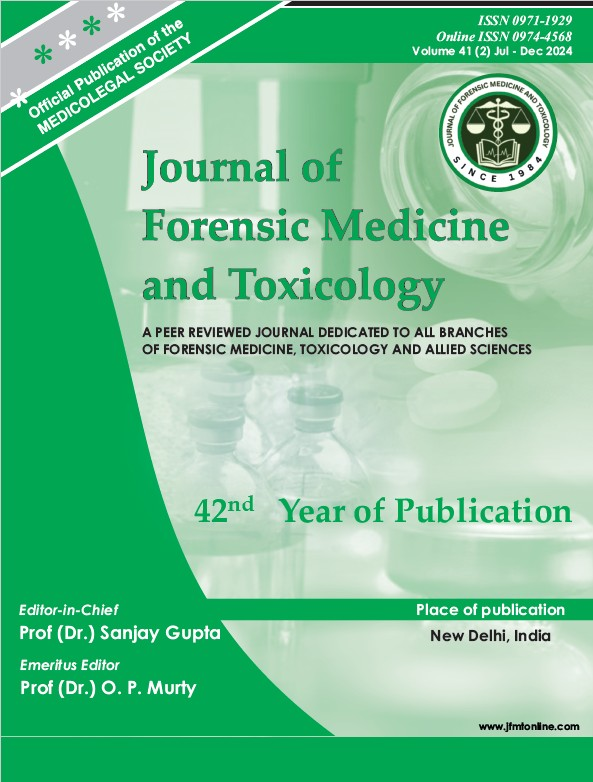TALE OF TORTURE EXPLAINED BY DEAD: A CASE REPORT
DOI:
https://doi.org/10.48165/jfmt.2024.41.1.26Keywords:
Torture, Death, Autopsy, Human rightsAbstract
Introduction: The autopsies of those who died due to torture are few in number due to the fact that these individuals’ bodies are frequently covered up, concealing the details of their deaths as well. When it comes to identifying torture, the role of forensic pathologists is becoming more and more crucial. Finding the truth about the medical consequences of fatal torture will raise awareness of torture-related injuries and strengthen forensic humanitarian work. Case report: An unidentified body of a male individual was brought to the mortuary by police for a routine autopsy. As per the information provided by police the apparent cause of death was “Agyaat karan” (Unknown reason). During autopsy, multiple modes of injuries including mechanical, thermal, ligature strangulation, and stress positioning were observed which indicates that the man was tortured to death, and all of these were explained by the dead.
Downloads
References
Declaration of Tokyo [Internet]. Wma.net. [cited 2024 Feb 28]. Available from: https://www.wma.net/what we-do/medical-ethics/declaration-of-tokyo/
Pollanen MS. The pathology of torture. Forensic Science International. 2018; 284:85–96.
Pollanen MS. The Dead Detainee: The Autopsy in Cases of Torture. Academic Forensic Pathology. 2017 Sep;7(3):340–52.
Thomsen JL. The role of the pathologist in human rights abuses. J Clin Pathol. 2000;53(8):569–72.
Saukko P, Knight B. Knight’s forensic pathology. 4th Ed. Boca Raton, New York: CRC Press; 2016.p.300- 3.
United Nations. Universal Declaration of Human Rights. United Nations. [cited 2024 Feb 28]; Available from: https://www.un.org/en/about-us/universal-
declaration-of-human-rights
Reddy KSN, Murty OP. The essentials of forensic medicine & toxicology. 35th Ed. New Delhi, India: Jaypee Brothers Medical; 2022.p.229
The Istanbul Protocol [Internet]. PHR. Physicians for Human Rights; 2018 [cited 2024 Feb 28]. Available from: https://phr.org/issues/torture/setting-anti-torture norms/istanbul-protocol/
Office of the High Commissioner for Human Rights. Istanbul Protocol [Internet]. The Office of the United Nations High Commissioner for Human Rights
(OHCHR). 2004 [cited 2024 Feb 28]. Available from: https://www.ohchr.org/en/publications/policy-and methodological-publications/istanbul-protocol manual-effective-0
Dogra T, Sanjeev Raina A. Role of Forensic Medicine Expert in Human Rights in India. OIDA International journal of Sustainable Development. 2010;2:11–5.
Herath JC, Pollanen MS. Clinical examination and reporting of a victim of torture. Acad Forensic Pathol. 2017;7(3):330–9.




